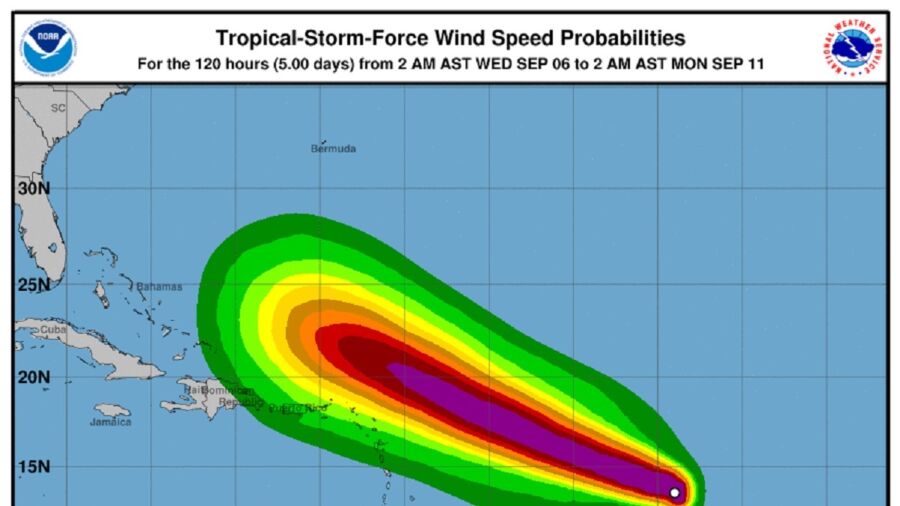Tropical Storm Lee is expected to “rapidly intensify” into an “extremely dangerous” hurricane by the weekend, the National Hurricane Center (NHC) has warned.
In a Sept. 5 update, NHC said the storm, which has formed over the Atlantic Ocean roughly 1,300 miles east of the Leeward Islands of the Caribbean, is forecast to become a major hurricane and could affect the Leeward Islands by the weekend.
“While it is too soon to determine the location and magnitude of these possible impacts, interests in this area should monitor the progress of Lee and further updates to the forecast,” NHC said.
Rapid intensification is defined by NHC as an increase in the maximum sustained winds of a tropical cyclone of at least 30 knots (roughly 35.5 mph) in a 24-hour period.
The NHC said winds from storm Lee were currently blowing at about 65 mph (100 kph) and were moving west-northwest at 14 mph (22 kph).
“Continued steady to rapid strengthening is forecast and Lee is expected to become a hurricane later today (Wednesday) and a major hurricane in a couple of days,” the center said.
The center added that swells generated by Lee are expected to reach portions of the Lesser Antilles on Friday. “These swells are likely to cause life-threatening surf and rip current conditions,” it said.
Storm Likely to Intensify
Tropical Storm Lee is not forecast to make landfall but experts forecast it will pass just northeast of the British Virgin Islands.
While experts said it is still too soon to determine which, if any, areas might be impacted by the storm, they have cautioned the group of islands— including the Virgin Islands, Saint Kitts, Nevis, and Guadalupe—as well as anyone in the eastern Caribbean—including the Leeward Islands, Puerto Rico, and Hispaniola— as well as the Bahamas, to remain vigilant for further updates.
The storm is expected to travel over record-warm waters of at least 86 degrees Fahrenheit east of the Lesser Antilles, Axios reports, which will likely see it intensify to the higher end of the Saffir Simpson intensity scale.
“Lee has already been strengthening fairly quickly despite some east-northeasterly vertical wind shear over the system,” NHC said in a separate update. “Since the shear is expected to relax while the storm remains over very warm water and in a moist environment, continued steady to rapid intensification is expected during the next few days. Most of the intensity models are very aggressive, bringing Lee to major hurricane status by the weekend, but they don’t show much change in strength in the short term.”
The latest storm comes just days after Hurricane Idalia made landfall along Florida’s Big Bend region as a Category 3 storm, causing widespread flooding and damage before making its way to Georgia and the Carolinas.
Hurricane Idalia Brings Billions in Damages
Three people—two in Florida and one in Georgia—were killed by that hurricane, which destroyed homes and downed powerlines.
One of the individuals killed in Florida was a 59-year-old man from Gainesville who died after veering into a ditch and hitting a tree while driving, officials said. The other was a 40-year-old man who died in Pasco County, part of Florida’s Big Bend region, in what officials said was a “weather-related accident.”
In Georgia, the third person was killed in Valdosta while attempting to dismantle a fallen tree, according to Lowndes County Sheriff Ashley Paulk.
Hurricane Idalia caused between $12 billion and $20 billion in damage, according to Moody’s Analytics.
Last week, the White House requested an extra $4 billion for FEMA’s natural disaster responses from Congress, which is slowly running out of funding, following a string of major disasters.
The latest request is in addition to a previous $12 billion request last month, part of an overall $40 billion stopgap funding ask.
In late August, FEMA officials said the remaining money in the federal government’s disaster relief fund would be prioritized for a string of recent and anticipated disasters, while other funding for long-term recovery projects and hazard mitigation projects will be put on hold pending congressional action to ensure FEMA’s Disaster Relief Fund is topped up.
According to FEMA’s most recent report (pdf), the disaster relief funds will run a $4 billion deficit by the end of September if it is not replenished.
It is not yet clear if Congress will agree to pass the additional disaster funding amid a dispute over the money being tied to more than $40 billion in emergency spending for Ukraine amid the ongoing Russian invasion.
From The Epoch Times

